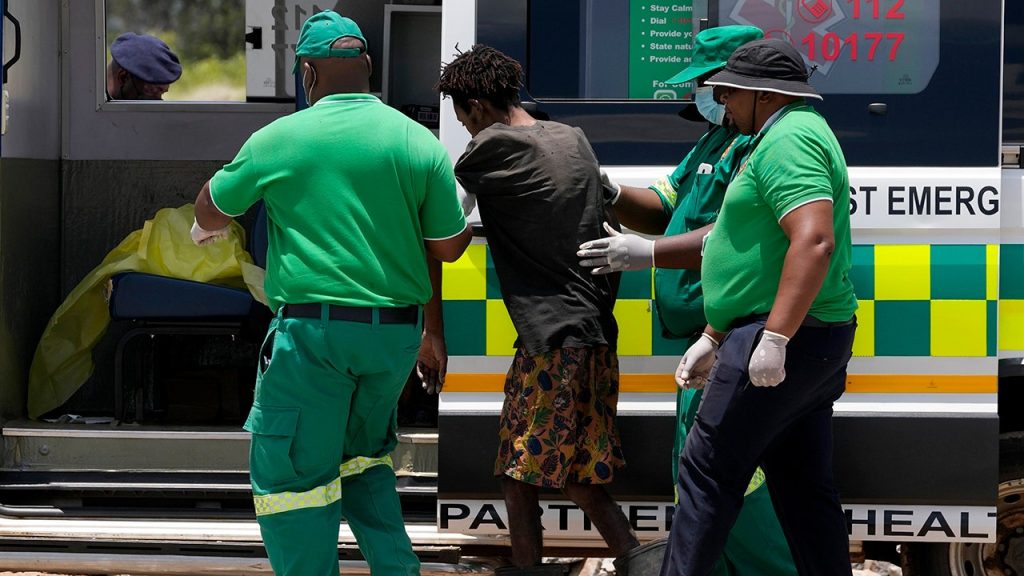The Buffelsfontein Gold Mine near Stilfontein, South Africa, became the site of a harrowing tragedy unfolding over several months, culminating in a desperate rescue operation in early 2024. Hundreds of illegal miners were trapped deep within the abandoned mine’s labyrinthine tunnels, facing starvation and dehydration after authorities cut off their supply lines in an attempt to force them out. The government’s initial response was met with widespread condemnation, as officials labeled the miners “criminals” and refused to offer assistance, even as reports of deaths underground started to emerge. The grim reality of the situation became undeniable as rescuers began bringing bodies and emaciated survivors to the surface, with estimates of hundreds more still trapped below, many likely deceased.
The initial strategy of cutting off supplies backfired dramatically, trapping the miners in a deadly predicament. While authorities argued that the miners could exit the mine if they chose to, activists and community members countered that the miners were too weak to navigate the perilous shafts and tunnels, especially given the mine’s depth of 2.5 kilometers and the complex network of passages within. The standoff between authorities, miners, and the local community intensified, with the government facing intense scrutiny for its handling of the crisis. Civic groups ultimately won a legal battle to compel authorities to allow food, water, and medicine to be delivered to the trapped miners. However, these supplies proved insufficient to alleviate the dire conditions underground, where starvation and dehydration continued to claim lives.
As the situation deteriorated, the community took matters into their own hands, organizing a rescue effort before the official operation finally commenced. The scale of the disaster became tragically apparent as rescuers began retrieving bodies and survivors, many of whom were severely malnourished and in desperate need of medical attention. Distressing cellphone videos emerged from the depths of the mine, depicting scenes of emaciated men and numerous bodies wrapped in plastic, starkly illustrating the horrific conditions underground. These videos, along with testimonies from survivors, painted a grim picture of desperation and suffering, with trapped miners pleading for help and food.
The official rescue operation, involving a cage-like device lowered thousands of feet underground, brought dozens of bodies and survivors to the surface. However, the exact number of miners remaining trapped remained uncertain, with estimates ranging into the hundreds. The slow and arduous process of rescuing those still alive faced immense challenges, including the mine’s depth, intricate layout, and the weakened state of the trapped miners. The operation, slated to last for ten days before reassessment, highlighted the complexities and dangers involved in reaching and extracting those still trapped within the mine.
The tragedy at Buffelsfontein underscores the pervasive issue of illegal mining in South Africa, driven by poverty and the allure of gold in abandoned mines. Mineral Resources Minister Gwede Mantashe revealed that over 1,500 miners had been arrested at Buffelsfontein since authorities initiated a crackdown on illegal mining in late 2023, the majority being foreign nationals from neighboring countries. While authorities maintained that the trapped miners refused to surface due to fear of arrest, activists argued that their weakened state prevented them from making the arduous journey to the surface.
The government’s initial response, characterized by a refusal to aid the trapped miners, sparked widespread condemnation and raised serious questions about their handling of the crisis. Critics argued that a more proactive and compassionate approach could have prevented many of the deaths. The incident ignited a public debate about the complex realities of illegal mining, the precarious conditions faced by those involved, and the government’s responsibilities in such situations. The tragic events at Buffelsfontein serve as a stark reminder of the human cost of illegal mining and the urgent need for comprehensive solutions to address this complex issue.

